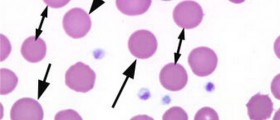Leukopenia Overview
Leukopenia is a hematologic disorder and it features with the decrease in the number of white blood cells. White blood cells primarily contribute to the protection of the body against different infective agents and this is why the reduction in their number typically results in different infections. Apart from infections people suffering from leukopenia are also susceptible to other medical conditions such as cancers.
Normal range of white blood cells in children is between 2000 and 4000 per cubic millimeter of blood. So, dropping below this determined level results in leukopenia. If the number of white blood cells is a bit reduced there are no symptoms and signs of the disease. However, a significant drop in white blood cells in children usually leads to infections and symptoms and signs of infection drive parents to the hospital where leukopenia is simply identified by a blood test.

- 21 children (6 girls and 15 boys, aged 10-17 years, mean 13.6, median 12 years) were analysed. The children were referred to our clinic by family physicians to investigate the reason of asymptomatic, lasting over three months leucopenia.
- These children are still under our observation from one till four years. Despite the fact of lasting over three months leucopenia, the general condition of the patients is good. In all the patients the myelogram analysis was performed after May-Grumwald-Giemsa dying, three slides of one hundred cells were counted.
- Mean number of leucocytes was 3.06x109/ l (median 2.75x109/l, values from 2.46x109/l to 3.53x109/l), mean number of neutrocytes was 1.15x109/l (median 1.07 x 109/l, values from 0.62x109/l to 1470x109/l).
- Hemoglobin concentration and platelets number were normal. Mean number of marrow cells were within references.
- However mean number of myelocytes, metamyelocytes, bands and eosynophils were lower than mean number of general population marrow cells (p
Causes of Leukopenia in Children
There are numerous medical conditions that are accompanied by leukopenia.
Malaria is one of the illnesses which may contribute to a drastic fall in white blood cell count. Malaria represents an infectious disease caused by sporozoan parasites. The parasite is transmitted via mosquito bite. Apart from leukopenia, a child suffers from fever and chills. This infection typically occurs in endemic countries and may affect children living in those countries or those who are visiting the endemic country with their families and who are not taking specific medications that prevent malaria.
Vitamin deficiency may be another cause of leukopenia in children. In these children, the lack of certain vitamins is induced either by an inappropriate diet or occurs due to the inability of the gastrointestinal tract to absorb specific vitamins.
Septicemia is a rather severe and life-threatening condition. The presence of bacteria and their toxin in the bloodstream affects numerous organs and organ systems and may lead to death. Apart from leukopenia children suffering from septicemia also experience fever, chills, vomiting, etc.
Banti's syndrome features chronic congestive spleen enlargement. The spleen destroys red and white blood cells and causes leukopenia.
Leukopenia is a typical feature of leukemia. In leukemia, leukopenia may be the culprit of infections that drive parents to pediatricians. After blood testing and a few more examinations and tests doctor set the definitive diagnosis. Aplastic anemia is one more blood disorder that apart from anemia features with a drop in white blood cells. The bone marrow cannot function properly and this affects the production of all three types of blood cells.
And finally, one more cause of leukopenia is systemic lupus erythematosus. This autoimmune disease may affect numerous organs and one of its characteristics may be leukopenia.
















Your thoughts on this
Loading...